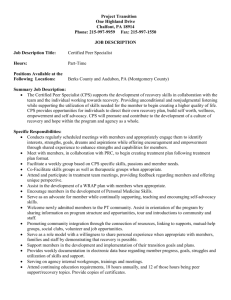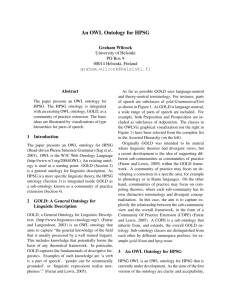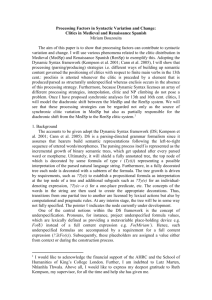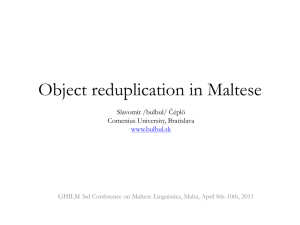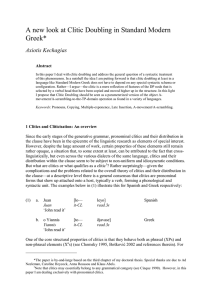Adele-Persian
advertisement
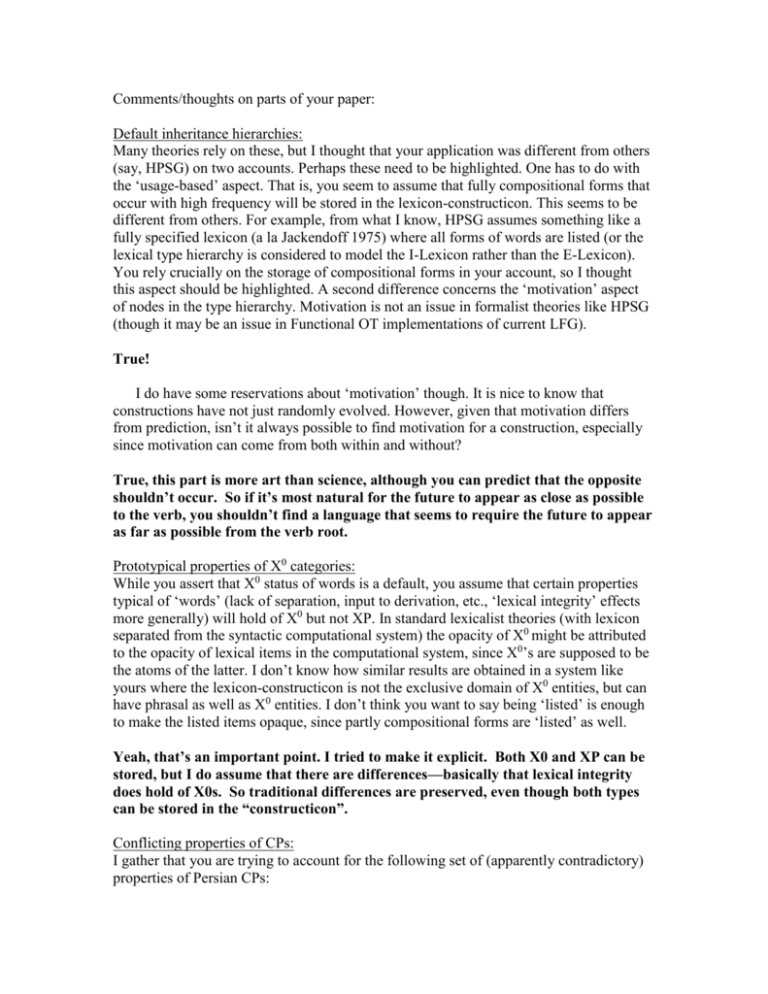
Comments/thoughts on parts of your paper: Default inheritance hierarchies: Many theories rely on these, but I thought that your application was different from others (say, HPSG) on two accounts. Perhaps these need to be highlighted. One has to do with the ‘usage-based’ aspect. That is, you seem to assume that fully compositional forms that occur with high frequency will be stored in the lexicon-constructicon. This seems to be different from others. For example, from what I know, HPSG assumes something like a fully specified lexicon (a la Jackendoff 1975) where all forms of words are listed (or the lexical type hierarchy is considered to model the I-Lexicon rather than the E-Lexicon). You rely crucially on the storage of compositional forms in your account, so I thought this aspect should be highlighted. A second difference concerns the ‘motivation’ aspect of nodes in the type hierarchy. Motivation is not an issue in formalist theories like HPSG (though it may be an issue in Functional OT implementations of current LFG). True! I do have some reservations about ‘motivation’ though. It is nice to know that constructions have not just randomly evolved. However, given that motivation differs from prediction, isn’t it always possible to find motivation for a construction, especially since motivation can come from both within and without? True, this part is more art than science, although you can predict that the opposite shouldn’t occur. So if it’s most natural for the future to appear as close as possible to the verb, you shouldn’t find a language that seems to require the future to appear as far as possible from the verb root. Prototypical properties of X0 categories: While you assert that X0 status of words is a default, you assume that certain properties typical of ‘words’ (lack of separation, input to derivation, etc., ‘lexical integrity’ effects more generally) will hold of X0 but not XP. In standard lexicalist theories (with lexicon separated from the syntactic computational system) the opacity of X0 might be attributed to the opacity of lexical items in the computational system, since X0’s are supposed to be the atoms of the latter. I don’t know how similar results are obtained in a system like yours where the lexicon-constructicon is not the exclusive domain of X0 entities, but can have phrasal as well as X0 entities. I don’t think you want to say being ‘listed’ is enough to make the listed items opaque, since partly compositional forms are ‘listed’ as well. Yeah, that’s an important point. I tried to make it explicit. Both X0 and XP can be stored, but I do assume that there are differences—basically that lexical integrity does hold of X0s. So traditional differences are preserved, even though both types can be stored in the “constructicon”. Conflicting properties of CPs: I gather that you are trying to account for the following set of (apparently contradictory) properties of Persian CPs: X0-like properties of CPs: (i) Primary stress on X0, rather than V0. (ii) Unpredictable argument structure of CP. (iii) Unpredictable case-marking (iv) Input to lexical nominalizations (v) X0 and V0 resist separation by adverbs and arguments Phrase-like (non X0-like) properties of CPs: (vi) X0 and V0 separated by future auxiliary. (vii) Imperfective and negative prefix attaches to V0, rather than X0. (viii) Object clitic may attach to X0, rather than V0. Your idea is that these properties can be accounted for through the interplay of different constructional constraints in a default inheritance hierarchy. Exactly The argument seems convincing overall, but I will try to play the devil’s advocate to see if there is a way of accounting for these facts without positing conflicting constructions/constraints. Suppose we take your analysis in Figure 1 as basic. That is, assume that CPs are of the following form (your Figure 1): V0 X0 V0 Positing this kind of structure would account for most, if not all, of the X0-like properties of CPs, which is what I gather you are also assuming. Stress assignment is presumably regular (though we need to look at stress in compounds to see what the relevant principles are). Non-compositionality/predictability in argument structure and caseassignment are probably expected, since the whole thing is an X0 (though see the second point I made earlier on what guarantees that X0’s will have such properties in a system like yours). Resistance to separation and input to derivation can be similarly explained. The problems, then, are (vi)-(viii). Not knowing all the relevant facts, I can only speculate, but let me give a stab at some alternative explanations. First, the future auxiliary. I have some questions about your analysis. In Figure 3, you assume that the general future construction is a V’, not V0. How do you know? Then you show the future-CP-v0 construction, but without specifying whether it is V’ or V0. The future CP construction has got to be a V’ because the future is inflected so very unlikely to be within the middle of an X0. For the imperfective and negative, if we assume that they are prefixes must attach to a verbal stem (or root), we might be able to explain why the prefixes go on the LV rather than on the X0. The relevant structure would be something like: V0 X0 V0 mi- V-1 (stem) Right, you can do that, but then you have to say that the negative marker goes in the middle of a word in Persian, a pretty stipulative, odd thing. For the object clitics, my understanding is that you don’t crucially rely on conflicting constraints and hierarchies. There are two strategies – (i) encliticize to the bearer of primary stress, and (ii) encliticize to V0, neither of which is a subcase of the other. You then show that only (i) can occur in the future construction because the future+verb is not a V0. So it seems that no crucial role is played by conflicting constraints or inheritance hierarchies. Some speakers insist on putting the clitic on the host instead of at the end of the entire CP—that would be unexpected if the CP is truly a V0 so I need to say that the clitic +CP construction preempts the VO-clitic construction for those speakers. At the same time, other speakers do allow both, which can easily be explained if the CP is a VO and both alternatives are available. I capture the difference by allowing for alternate ways of forming the inheritance hierarchy—since considered theoryneutrally, either seems reasonable, I think it’s not unreasonable to expect some differences. - Finally, in analyses of similar ‘paradoxes’, people also look at Gapping (of part of CP) and coordination (i.e., can you coordinate two X0’s with one light V0?). I wonder if you’ve looked at these in Persian CPs. Yep, good point. I did, along time ago—the facts are very messy and depend a lot on semantic factors (like how transparent the CP is). I could never find two speakers to agree, so I ended up dropping that part.
